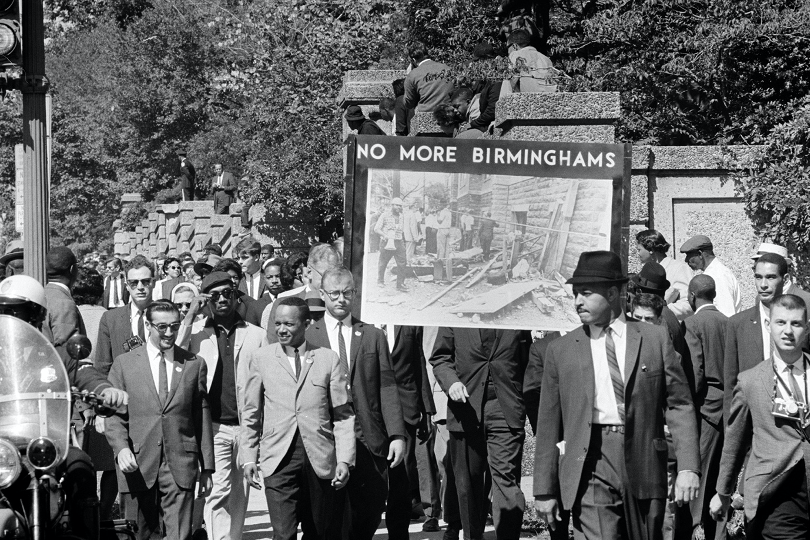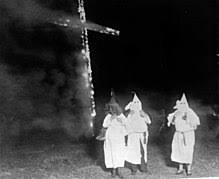2. Racism and violence against African Americans; the Ku Klux Klan;
The following source paper is on the actions of the KKK. Click on the eye to see the sources or download the PDF.
Source A
Dwight James, a journalist and member of the National Association for the Advancement of Coloured People [NAACP], in an article for an NAACP newspaper, Why we will remember Medgar Evers. 1970
The Ku Klux Klan [KKK] has moved through three distinct phases in its history, in the first phase it set out to oppose reconstruction, occupation and emancipation, in its second phase its agenda was to enforce the Jim Crow laws, and in the third phase it has pursued an anti-civil rights and white supremacy agenda. The NAACP, which had sought legal redress to segregation in the South, had a great victory in the Brown v Board of Education of Topeka decision in 1954, which subsequently strengthened support for its judicial strategy. At the same time, the 1954 ruling also led to a growth in Klan membership and an escalation in KKK violence.
Klan members attacked the civil rights movement using assassinations of targeted individuals as a primary tactic. They murdered civil rights activists across the South. Despite resistance from activists and their allies, violence and attacks continued unabated. Indeed, although the Federal Bureau of Investigation [FBI] had paid informants in the Klan, the organization was more concerned with uncovering links between civil rights activists and communists than the violence of the Klan. The FBI had even infiltrated the NAACP. The Klan also had some support in local government in the South. However, the turning point was the KKK assassination of the NAACP secretary Medgar Evers in Mississippi in June 1963. President Kennedy understood that racial violence was deeply damaging to the reputation of the US overseas as the Evers murder made headlines across the world. Kennedy was now determined to take broader measures to end the discrimination and violence.
Source B
Rita Richards, a professor of African American history, writing in the academic book, Civil Rights and the Klan. 2019.
When the Supreme Court ordered school integration in 1954, the Ku Klux Klan were determined to oppose the law and maintain segregation. Similar to the Southern opposition to Reconstruction government, the Supreme Court decision provided the groundwork for a Klan resurgence. The ruling subsequently led to organised, violent and sustained attacks against the civil rights movement by the Klan.
The primary strategy of Klansmen was the use of bomb attacks against the African American population in order to instil terror. Starting in January 1956, with an attack on the home of Dr. Martin Luther King Jr., by June 1, 1963, 138 bombings, believed to be perpetrated by the Klan had been reported. Indeed, in 1963 the South was in crises due to protests and violent attacks by the KKK. Membership of the Klan had mushroomed to 50,000 and it had the backing of some in local government. But, one bombing in particular stood out in the history of the Klan and it proved to be the turning point. On September 15, 1963, a bomb ripped through the 16th Street Baptist church in Birmingham, killing four young African American girls and injuring twenty two others. This was the key moment as it outraged US society - the death of the four girls caused shock and horror across the nation. Pressure from domestic public opinion then forced President Kennedy to take action at a federal level.
Source C
A photograph of the Congress of Racial Equality [CORE] March held in memory of four girls killed in the Klu Klux Klan’s bombing in Alabama of the 16th Street Baptist Church. Washington, 1963.

Source D
Excerpt from the US Democratic Party presidential election manifesto. One Nation, One People. 1964.
We are firmly pledged to continue the Nation's march towards the goals of equal opportunity and equal treatment for all Americans regardless of race, creed, color or national origin.
We cannot tolerate violence anywhere in our land--north, south, east or west. Resort to lawlessness is anarchy and must be opposed by the Government and all thoughtful citizens.
We must expose, wherever it exists, the advocacy of hatred which creates the clear and present danger of violence.
We condemn extremism, whether from the Right or Left, including the extreme tactics of such organizations as the Communist Party and the Ku Klux Klan.
We know what violence and hate can do. We have seen the tragic consequences of misguided zeal and twisted logic.
These are the principles which command our cause and strengthen our effort as we cross the new frontier and enter upon the great society.
Questions:
1.a] What, according to Source D, were the key points of the Democratic party’s ‘One nation, one people’ platform in 1964?
1b] What does Source C suggest about the response to Ku Klux Klan violence in the US?
2. With reference to its origin, purpose and content, analyse the value and limitations of Source A for an historian studying the impact of Ku Klux Klan violence on the civil rights movement.
3. Compare and contrast what Source A and B reveal about the nature and impact of Ku Klux Klan violence against African-Americans.
4. Using the sources and your own knowledge, discuss the impact of KKK violence against African-Americans on the civil rights movement up to 1965.
This is the markscheme for the paper. Click on the eye or download the PDF
1.a] What, according to Source D, were the key points of the Democratic party’s ‘One nation, one people’ platform in 1964?
- Promotion of equal opportunity and equal treatment of all regardless of race or creed.
- There would be no tolerance of violence anywhere
- There must be the exposure of the advocacy of hatred which creates the danger of violence
- It condemned extremism including the Communist Party and the Ku Klux Klan
1b] What does Source C suggest about the response to Ku Klux Klan violence in the US?
- The violence had led to protests in Washington
- Mixed race crowds gathered to protest
- Images of the violence were used in the protest
2. With reference to its origin, purpose and content, analyse the value and limitations of Source A for an historian studying the impact of Ku Klux Klan violence on the civil rights movement.
Value
- As a former member of the NAACP he is likely to have knowledge of the situation. The author benefits from some hindsight on events.
- Its intention is to highlight the impact of the KKK assassination of former NAACP member on the progress of the civil rights movement.
- The source details KKK violence and how it influenced the Kennedy administration to take action.
Limitations
- As a member of the NAACP the author may exaggerate the impact of this assassination on the government.
- The article is intended to memorialise Medgar Evers
- The source does not provide details of how events unfolded after 1963
3. Compare and contrast what Source A and B reveal about the nature and impact of Ku Klux Klan violence against African-Americans.
Comparisons
- Both sources identify the Supreme court ruling on school integration as strengthening support for the Klan
- Both sources suggest that the Klan used terror tactics to intimidate civil right activists
- Both suggest that KKK violence led the president to take action to redress the situation in the south
Contrast
- Source A states that the primary tactic of the Klan was assassinations of key activists whereas Source B states that it primarily used bomb attacks against the black population.
- Source B identifies that the key act by the KKK was the bombing of the 16th Street Baptist church whereas Source A suggests that the turning point was the assassination of Medgar Evers.
- Source A suggests that the President responded to international pressure when deciding to act against KKK violence whereas Source B asserts that Kennedy decided to take action due to domestic public opinion.
4. Using the sources and your own knowledge, discuss the impact of KKK violence against African-Americans on the civil rights movement up to 1965.
Source A
The Klan assassinated key figures in the civil rights movement which may have undermined it in the South. The KKK also had supporters in local government and the FBI did not take action against its violence, focusing on the threat of communist links with the civil rights movement. But, the KKK’s assassination of the NAACP secretary Medgar Evers in Mississippi in June 1963 led President Kennedy to take broader measures to prevent the violence which was damaging the reputation of the US overseas
Source B
KKK violence had led to a crisis in the South. The bombing of the 16th Street Baptist church in Birmingham in September 1963, in which four young black girls were killed shifted US public opinion which was shocked and horrified at the actions of the KKK. This furthered the cause of the civil rights movement as the President was forced to act.
Source C
The bombing of the 16th Street Baptist church led to protests in Washington by both black and white supporters of the Congress of Racial Equality. Images of the bombing were used to gain public support for the civil rights movement.
Source D
In 1964, the Democratic Party had identified the KKK as an extremist organisation and condemned its use of violence. The Democratic Party pledged to continue the Nation's march towards the goals of equal opportunity and equal treatment for all Americans regardless of race, creed, color or national origin in its election manifesto.
Own knowledge
- Klan’s campaign of terror against the civil rights movement may have deterred open support for campaigns.
- Violence continued after 1963, including the infamous killing of three civil rights activists in Mississippi in 1964.
- Details of the FBI focus on communists links with the civil rights movement could be developed. It may be argued that Kennedy’s response to KKK violence was limited at the time.
- Disenfranchisement of blacks in the south continued and court cases were heard by all white juries.
Nevertheless
- Brutality of the KKK, for example, during Freedom Rides in 1961, led to widespread media attention which in turn led to increasing support for the civil rights movement in the US.
- Klan violence attracted negative international attention that put pressure on the federal government. It was used in Soviet propaganda to claim that the US was hypocritical in promoting ‘democracy, equality and freedom’.
- President Kennedy’s televised June speech called for a civil rights act that would address the problem of discrimination, a position that was galvanised by the murder of Medgar Evers.
- The Civil Rights Act was backed by Martin Luther King in the Washington march of August 1963. It was within the context of KKK violence MLK’s "I have a dream” speech had so much traction and power.
- The movement succeeded in achieving the Civil Rights Act passed in 1964, and after more Klan violence and intimidation the Voting Act passed in 1965; in the same year the House Un-American Activities Committee began investigating the KKK

 IB Docs (2) Team
IB Docs (2) Team

